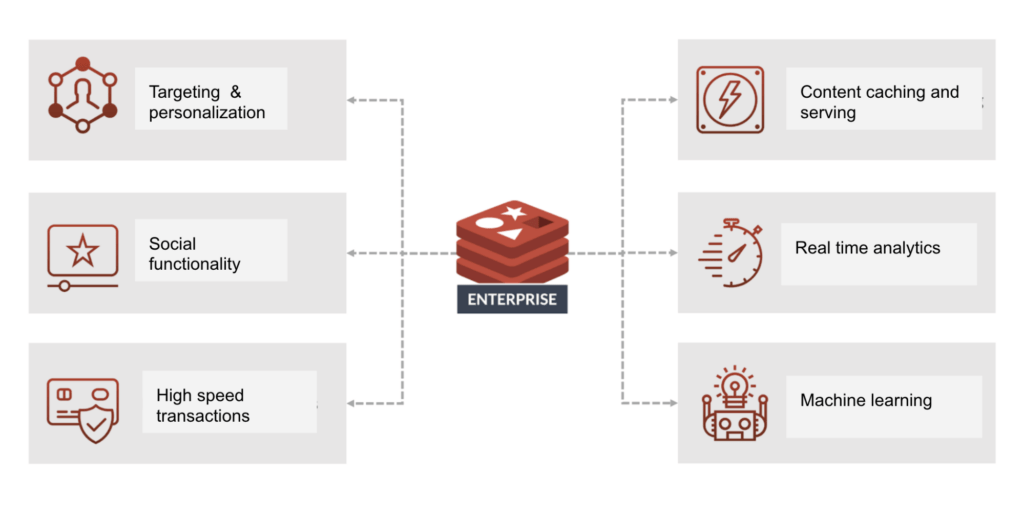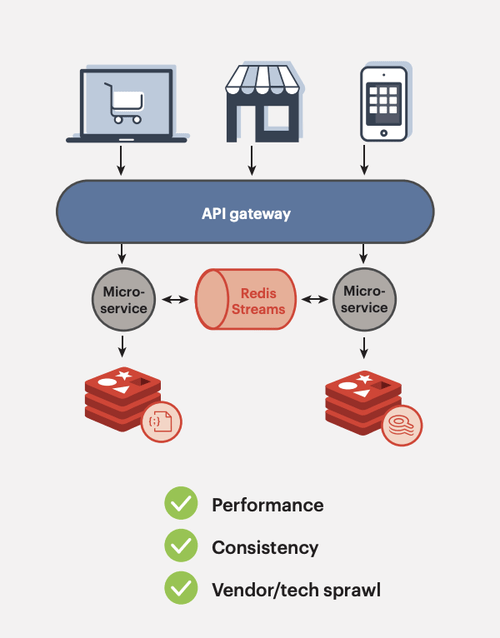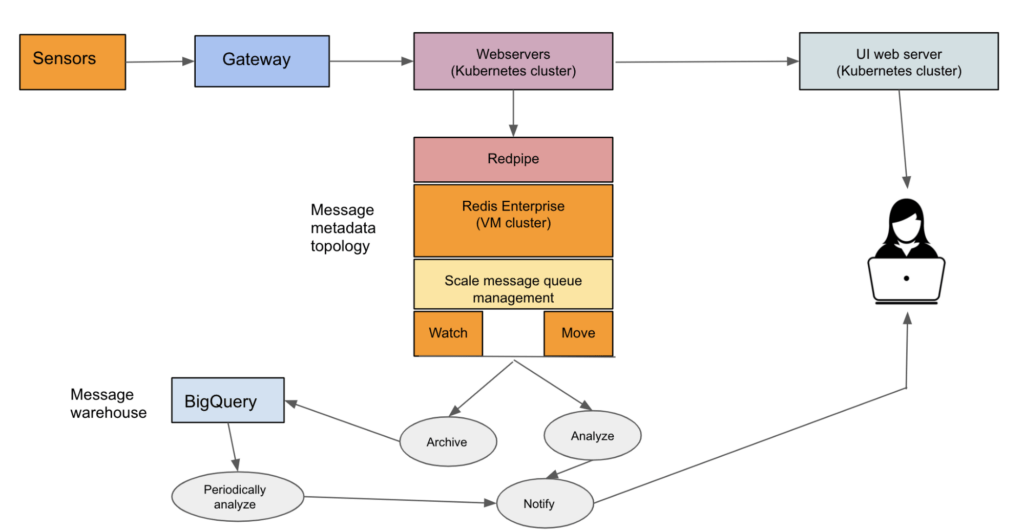- Home
- Technical Products
Enterprise Cloud IT Solutions
Test Measurement
Industrial Measurement
- Solutions
Enterprise Cloud IT Solutions
Test Measurement
- Resource Center
- About Us
 EN
EN
Hongke Articles
The Five Best Redis Use Cases
Redis has a great reputation and is widely recognized. Developers rely on Redis Enterprise to address key use cases across multiple industries, including gaming, retail, IoT, and travel application development.
So how can developers utilize Redis for their database needs? Initially, Redis started as an open source project, but over the past 13 years, as the digital business has grown, so have the demands on the database. This means higher availability, more durable storage, and no tolerance for performance lags. As a result, backup enablement and real-time failover have become must-have features.
Achieving painless business scalability is a major development goal for any programming team. By utilizing the in-memory cache and in-memory database provided by Redis Enterprise, developers are able to reduce business complexity and latency by getting the dual support of Redis Enterprise in a single system.
The key to everything is speed. This includes speeding up application interactions (e.g., fast data retrieval and cache load balancing for back-end services) and building microservice architectures characterized by low latency based on user requirements (built with Redis' multimodal database).
Next, let's explore some well-known Redis use cases, as well as real-world Redis performance examples from our customers.
i. Rapid fraud detection for real-time decision making
Detecting fraud quickly is critical in real-time decision making. According to LexisNexis, every $1 of fraud now costs U.S. retail and e-commerce merchants $3.75, up 19.81 TP3T from 2019.
Israeli digital identity company BioCatch utilizes its breakthrough biometric tracking technology to identify fraudsters. With the company's business rapidly growing to 70 million users, 40,000 operations per second, and 5 billion transactions per month, the BioCatch team needed a way to deal with significantly larger databases.
The number of online transactions has surged due to COVID-19. According to Morgan Stanley's Global E-Commerce Growth Forecast to 2022, the e-commerce market size is expected to soar from the current $3.3 trillion to $5.4 trillion by 2026. Along with this growth come cybersecurity dangers: digital identity threats, cybercrime and customer fraud. According to a report by Bolster.AI, phishing and fake pages increased by 53% in 2021.
When constructing finely tuned fraud detection algorithms, the data layer has high latency requirements and needs to respond within 40 milliseconds to avoid negatively impacting the customer experience.
Data breaches have become a widespread problem, with IBM reporting that 83% organizations have experienced multiple data breaches at an average cost of approximately $4.3 million per incident. The U.S. has been ranked as the country with the highest average total cost of a data breach for 12 consecutive years.
As complexity, volume and threats increase, more advanced fraud detection methods are needed to respond to fraudsters and build stronger defenses. Traditional data platforms often struggle to cope with the speed, scale and complexity of modern online transactions, making it difficult to detect and stop fraud in real time.
As a result, BioCatch turned to Redis Enterprise to leverage its robust performance, high availability, and seamless scalability to meet these challenges. Initially, it considered Redis Enterprise as a cache, but the team quickly realized that Redis could also serve as an excellent NoSQL database.
BioCatch leverages Redis features and diverse data structures to create a single-source-of-truth database that serves critical information across the organization.BioCatch captures behavioral, metadata, and API data during active user sessions. It also creates a subset of user behavior profiles and predefined fraud profiles.
With 3 petabytes of data and 300 million keys in 40 databases running on Microsoft Azure, BioCatch relies on Redis Enterprise to provide data for all of its microservices. Since using Redis Enterprise, BioCatch has realized zero downtime and no-operations maintenance, allowing its team to focus on core strategic projects.
Modern Gaming Experience
According to Mordor Intelligence, the global gaming market was valued at $198.4 billion in 2021 and is projected to grow to $339.95 billion by 2027, with much of this growth attributed to the rise of mobile gaming.
For mobile gaming to be successful, the first thing you need to ensure is a great user experience, which is especially important in real-time multiplayer games, and this places high demands on the infrastructure. It is important to ensure that users are able to start the game, connect to the server, and interact with other players quickly and smoothly; any delays or failures can jeopardize the overall gaming experience. In addition, the gaming experience includes real-time transactions, sometimes involving the use of real money.

Developers rely on the low-latency nature of Redis to deliver high performance and virtually unlimited scale, which is critical in gaming environments that handle large amounts of high-speed data. Virtual sports, for example, is estimated to be a $48 billion market by 2028. American football is the most popular virtual sports game in the U.S., with 35 million players. But according to a study by the Federation of Indian Fantasy Sports (FIFS), it pales in comparison to India's Virtual Cricket League game, which has around 100 million players.
In India, teams are announced before the match and online players have only 10-15 minutes to update their respective fantasy teams. This requires a lot of data to be received, but should not affect the customer experience, especially when time is of the essence.
For game developers, delivering game elements such as graphics, pictures, thumbnails, and music requires a robust caching solution that relieves the burden of data storage running on a relational database such as MySQL, while ensuring extremely fast response times.
Caching delivers a responsive user experience while minimizing overhead. For example, Scopely's mobile game The Walking Dead: Road to Survival relies on Redis Enterprise for everything from leaderboards and API management to queue workload management.
Scopely needs to support a variety of data structures and features such as customized expiration, obsolescence policies, smart caching, request pipelines, data persistence, and high availability. These requirements cannot be met by a SQL database unless a complex load balancing cluster is used.

Data is at the heart of any leaderboard. A game's leaderboards can only be updated as fast as the data responds to it. If you want to meet the high expectations of your game and your players, then your leaderboard database needs to meet these technical requirements.
Omni-Channel E-Commerce Framework
When it comes to an omnichannel e-commerce framework, creating a fully digitalized business is a daunting task with a steep learning curve. A good digital business requires a backend that ensures store pages are available, an inventory management system, a fast caching autocomplete feature for the website, a product search engine, and machine learning technology to create a personalized customer experience in real time. And it all has to be high-performance; according to a 2020 YOTTA study, 90% shoppers said they would quit using a Web site if it responded too slowly.
Modern multichannel retailers are turning to real-time inventory systems to optimize inventory, yield and supply chain logistics to improve customer experience and supply chain efficiency. Building and maintaining these complex systems is a difficult and complex task for application developers.
In this case, performance becomes critical. Delayed or inaccurate inventory information can lead to a degraded shopping experience and complaints from customers, which in turn can lead to abandoned carts and canceled orders, resulting in lost revenue, increased costs, and a tarnished brand image.

For example, apparel retailer Gap Inc. wanted to provide its e-commerce customers with real-time shipment information for every item in their shopping carts. The company faced problems with delays and inaccurate inventory information, which led to a poor customer experience that not only increased costs but also damaged brand loyalty.
Application developers at Gap Inc. have found that Redis Enterprise's linear scalability and sub-millisecond performance at scale have been extremely helpful in coping with seasonal peaks such as Black Friday. Meanwhile, in a microservices environment, the fast, flexible data model prevents over-provisioning of infrastructure during low peak periods.
Therefore, ensuring availability, speed, performance and experience is key to realizing a truly seamless experience.
Open up new sources of revenue through real-time analysis and high-speed data ingestion
In the era of big data, a key challenge for organizations is how to collect, store and process large amounts of data in real time. While there are many solutions that support rapid data ingestion, they are often too complex and over-designed for simple requirements such as real-time streaming of data from IoT and event-driven applications.

In such applications, fast data analysis is critical to making quick business decisions. These use cases usually do not tolerate data loss. However, data loss is indeed a common problem when using traditional relational databases. SQL databases are often built around specific use cases, and introducing new data structures or data models into the SQL technology stack may result in overall performance degradation due to slowdowns, inefficient data ingestion, and data loss, which is often caused by the need for the data to be transformed to fit the model chosen by the database. This is often caused by the data needing to be transformed to fit the model chosen by the database.
Lost data means lost potential business opportunities. Therefore, any lost data could be the key to exploring new revenue streams.
A notable example is the use case of Inovonics, which provides high-performance wireless sensor networks with over 10 million devices deployed worldwide. Throughout its 30-year history, Inovonics has primarily considered itself a wireless technology provider. But with the advent of the Big Data era, Inovonics realized that the unique data sets collected by its wireless devices and sensors had tremendous business value.
Inovonics' Edge Platform needed a robust data platform capability to ensure flexibility and performance while minimizing its operating costs. By adopting Redis Enterprise Cloud, a fully automated database-as-a-service (DBaaS), Inovonics centralized all of its data in the Google Cloud, opening up new product offerings in the form of insight-rich, easy-to-access data analytics it is known for.

Inovonics uses Redis Enterprise on its IoT edge devices to push data to its gateways and then from those gateways to the company's private Google Cloud platform. On Google Cloud, Redis Enterprise is applied as the data ingestion layer, storing millions of daily messages from Inovonics' sensor network and providing a centralized, aggregated view to analyze the data. redis Enterprise also stores application data models so that incoming messages can be correlated with relevant information such as sensor locations. This approach not only improves the efficiency of data ingestion and analysis, but also opens up new revenue streams for Inovonics.
E. Easily realize business expansion
COVID-19 not only presents a challenge to brick-and-mortar retailers, but also forces technology providers to recalibrate and customize their operations and application delivery models. In order to maintain business continuity and achieve scale, organizations need the right tools and technologies to scale infrastructure and accelerate application response times.
Take Freshworks, for example, a company that develops cloud-based business software suites. Over the past six years, the company has worked hard to expand its application architecture and development operations due to rapid business growth. As the load on the database increased, maintaining performance became a challenge. The team wanted to dynamically scale the cluster without impacting business availability, and to reduce the burden on its primary MySQL database to accelerate application response.
After evaluating a variety of NoSQL memory databases such as Aerospike and Hazelcast, Freshworks chose Redis to capitalize on its high performance and flexibility. Ultimately, they adopted Redis Enterprise Cloud to ensure high availability and a seamless database experience for the developer's infrastructure services.

Freshworks uses Redis Enterprise as the front-end cache for its MySQL database and utilizes Redis' efficient data structures such as hashes, lists, and ordered collections, as well as built-in Redis commands to meter API requests into its Freshdesk software. At the same time, Redis Enterprise also serves as persistent storage for back-end operations, stored on disk. As the company moves to a microservices architecture, it has begun to separate critical workloads from the monolithic Ruby on Rails web application framework, with one microservice dedicated to authentication using Redis Enterprise as session storage.
In addition, Freshworks leverages Redis Enterprise's powerful data structures, such as HyperLogLog, bitmaps, and collections, as a front-end database for user analytics.
The above case studies are just a few examples of use cases where Redis Enterprise is the best choice. However, there are several features worth emphasizing.
buffer
The cache layer stores repetitively requested data and delivers it with sub-millisecond response times, speeding up loading and reducing back-end stress. Enterprise-class memory cache scales linearly and maintains performance stability. Fast data retrieval equals faster response times for users. Fast caching also balances the load on back-end services, allowing existing hardware to run at peak performance.
(Note: Some Redis service providers, such as Amazon ElastiCache, only support Redis as a cache and not as a master database.)
Chat, Messages and Queues
In a microservices architecture, powerful messaging solutions are critical. These various collections of services need to maintain communication with each other in a distributed environment. Messaging protocols such as Pub/Sub are indispensable for implementing real-time broadcast notifications with minimal latency and high throughput. Sorted sets and hashes provide support for chat rooms, social media dynamics, real-time comment streaming, and inter-server communication. Another data structure, lists, helps create lightweight message queues.
Session Storage
Session management relies on personalization, where applications need to process large amounts of data while caching and retrieving user profiles and session metadata. With reliable session storage, you can scale to billions of field-value pairs in sub-millisecond response times and handle unexpected traffic spikes.
Session Storage manages session data and improves availability, authentication, user profile and logging performance by caching IDs and tokens. It reduces the load on the primary database and computing resources, ultimately saving money.
Geospatial Indexing
Geospatial data integrates location-based functions such as estimating distance, arrival time and neighborhood recommendations. Geospatial indexing allows storing and searching for coordinates using commands (e.g. GEOADD, GEODIST, GEOHASH, etc.).
Fast, powerful and easy to use. What else can you expect?
Developers have to try their best to deliver application updates with attractive new features. This keeps them busy, as the overlay of apps often struggles to meet the expectations of the user base.
To accelerate time-to-market, development teams must achieve sub-millisecond response time performance and find simple ways to apply multiple data models to gain the freedom they need to build software.
Redis Enterprise provides a fast, powerful, and easy-to-use solution that helps development teams quickly build compelling new applications, unlock sub-millisecond response time performance, and simplify the process of applying multiple data models. When you start building your next application, what will you choose? Learn these classic examples of using Redis to build your own powerful applications with the ultimate in efficiency and performance.



